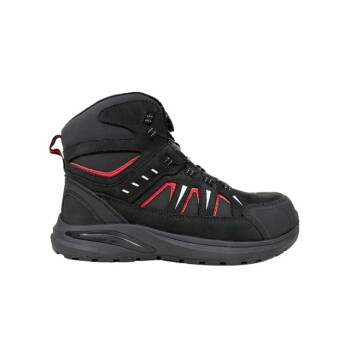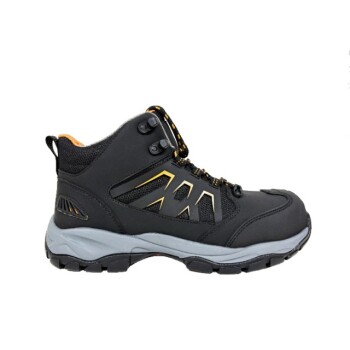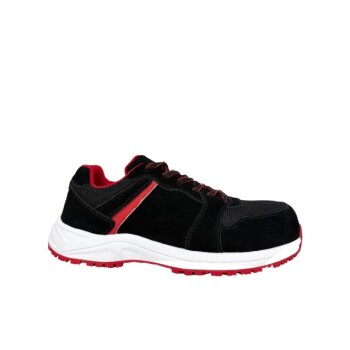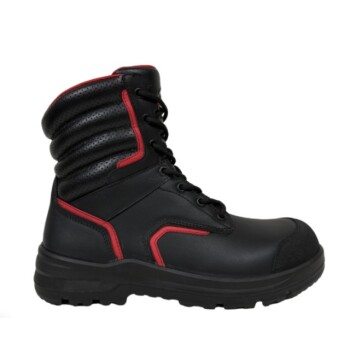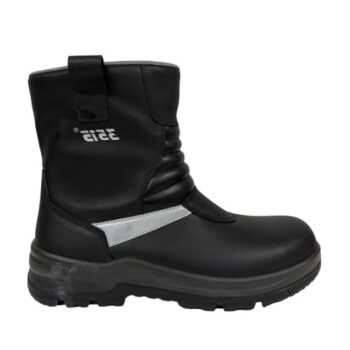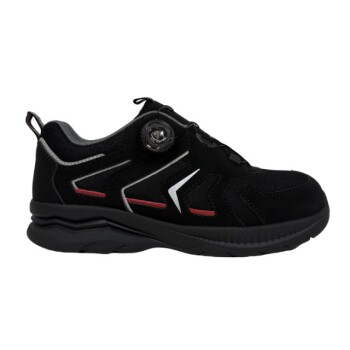The fundamental difference is that "safety toe" is the broad category of protective footwear, while "steel toe" is a specific type of safety toe. The real question isn't about steel versus safety, but about which safety toe material—be it steel, composite, or alloy—is the right tool for your specific job.
The term "safety toe" refers to any boot with a protective cap meeting ASTM safety standards. The choice between materials like steel and composite is a critical trade-off between maximum impact resistance, weight, and environmental factors like temperature and electrical conductivity.

What Defines a "Safety Toe"?
The Protective Standard
A "safety toe" boot is defined by its reinforced toe cap designed to protect your feet from compression and impact hazards.
To qualify, these boots must meet standards set by organizations like the American Society for Testing and Materials (ASTM). The ASTM F2413-18 standard is the current benchmark for protective footwear in the United States.
Beyond a Single Material
While steel was the original standard, modern safety toes are made from several materials. Each material meets the same core safety requirements but offers a different set of advantages and disadvantages.
The Core Materials: A Head-to-Head Comparison
Understanding the properties of each material is the key to selecting the right boot. The two most common types are steel and composite.
Steel Toes: The Classic Standard
Steel toe caps are the traditional choice for heavy-duty protection. They are formed from heavy-gauge steel, providing robust defense.
They offer the highest level of protection against impact and compression, making them ideal for rugged environments like construction and manufacturing. Steel is also often the most cost-effective option.
Composite Toes: The Modern Alternative
Composite toes are made from non-metal materials, such as Kevlar, carbon fiber, or high-density plastics.
Because they don't contain metal, they are significantly lighter than steel. This makes them a more comfortable choice for long days on your feet.
Understanding the Trade-offs: Key Decision Factors
Your work environment dictates which material is best suited for your needs. The decision comes down to three primary factors.
Protection vs. Weight
Steel offers superior resistance to crushing and impact forces. Its strength allows the protective cap to be thinner and less bulky than a composite cap offering similar protection.
Composite toes, while meeting ASTM standards, can be bulkier to achieve the required protection level. Their primary advantage is their significantly lower weight, which reduces foot fatigue.
Environmental Conductivity
This is a critical safety differentiator. Steel is a conductor, meaning it will transfer heat and cold to your feet in extreme temperatures. More importantly, it conducts electricity.
Composite materials are non-conductive. This makes them the only appropriate choice for electricians or anyone working in environments with a significant electrical hazard. They also provide much better insulation in very hot or cold conditions.
Metal Detectors and Security
Because they are metal-free, composite toe boots will not trigger metal detectors. This is a major advantage for workers who frequently pass through security checkpoints, such as in airports, government buildings, or secure facilities.
Making the Right Choice for Your Work Environment
Your choice should be based entirely on the specific hazards and requirements of your job.
- If your primary focus is maximum impact protection in heavy industry: Choose steel toes for their unparalleled strength and durability in construction or manufacturing settings.
- If your primary focus is working with electricity or in extreme temperatures: Choose composite toes for their critical non-conductive and insulating properties.
- If your primary focus is comfort and passing through security checkpoints: Choose composite toes to reduce weight and avoid the hassle of metal detectors.
Ultimately, selecting the right safety toe is about matching the material's specific strengths to the demands of your workplace.
Summary Table:
| Feature | Steel Toe | Composite Toe |
|---|---|---|
| Primary Material | Heavy-gauge steel | Kevlar, carbon fiber, plastic |
| Protection Level | Highest impact/compression resistance | Meets ASTM standards, can be bulkier |
| Weight | Heavier | Lighter, reduces fatigue |
| Electrical Hazard | Conducts electricity (Not for electricians) | Non-conductive (Safe for electricians) |
| Temperature Insulation | Conducts heat/cold | Provides better insulation |
| Metal Detectors | Will trigger | Will not trigger |
| Ideal For | Heavy industry, construction, manufacturing | Electrical work, extreme temps, security sites, long comfort |
Need High-Quality Safety Footwear for Your Team?
As a large-scale manufacturer, 3515 produces a comprehensive range of ASTM-certified safety boots for distributors, brand owners, and bulk clients. Whether your priority is the maximum protection of steel toes or the lightweight, non-conductive benefits of composite toes, we have the right solution for your specific work environment and hazards.
Let us help you equip your workforce with the perfect fit.
Contact us today for a quote and discuss your bulk footwear needs.
Visual Guide
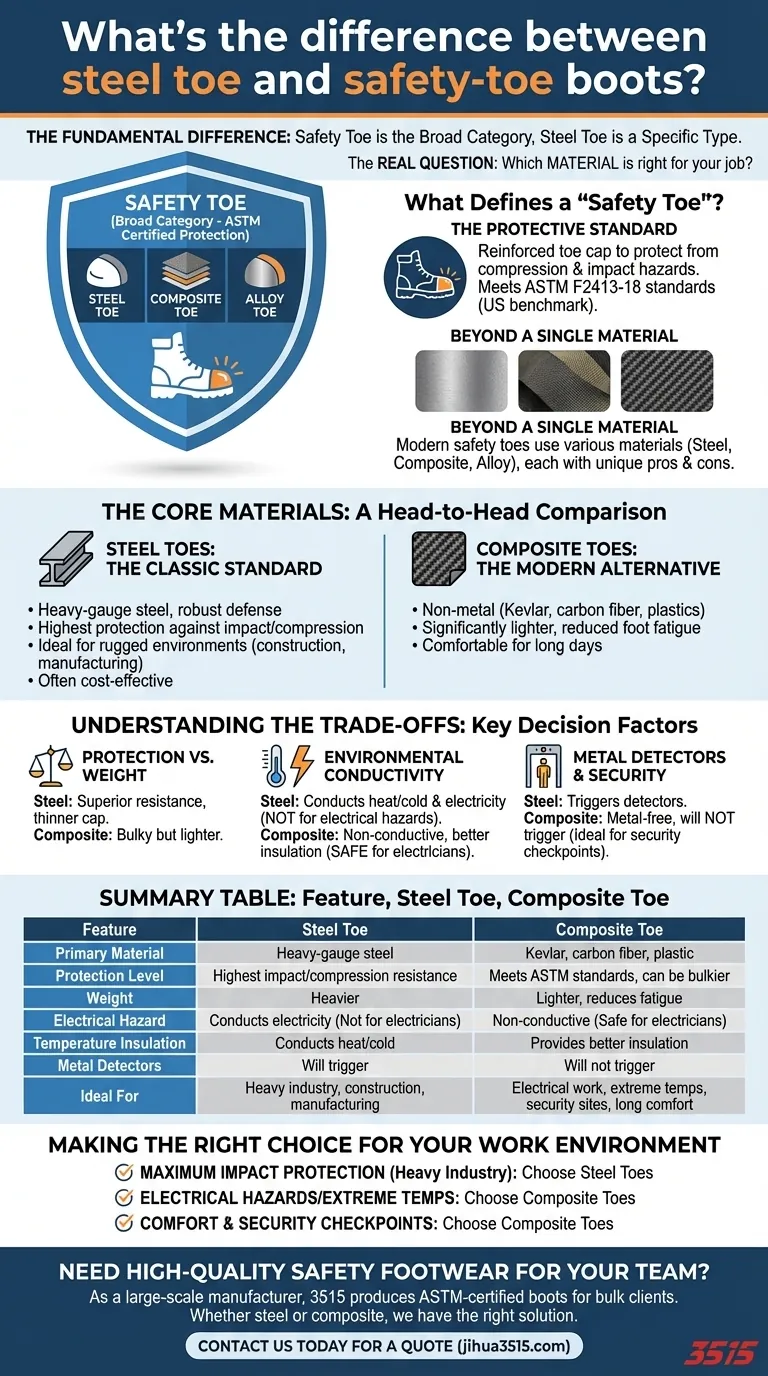
Related Products
- Wholesale Premium Waterproof Nubuck Safety Shoes Boots
- Heavy Duty Nubuck Safety Boots Safety Shoes for Global Distribution
- Premium Sport Style Safety Boots for Bulk Orders
- Premium Suede Sport Safety Shoes for Wholesale & Bulk Orders
- Advanced KPU Athletic Safety Shoe with Steel Toe Cap Anti-Slip Rotary Lacing System
People Also Ask
- How do safety boots reduce cutting hazards? Essential Protection for Your Workforce
- What protection do work boots offer against sharp objects? Your Guide to Puncture-Resistant Footwear
- What does the infographic mentioned in the article cover? Prevent Workplace Foot Injuries with the Right Safety Footwear
- What is the importance of wearing safety shoes in the workplace? Protect Your Team and Your Bottom Line
- What safety boots are recommended for the construction industry? Ensure Maximum Protection on the Job Site

